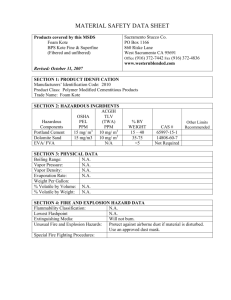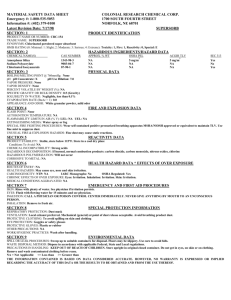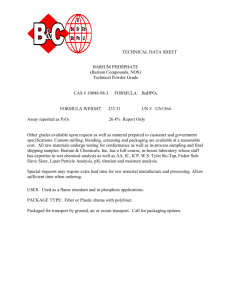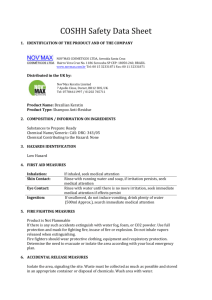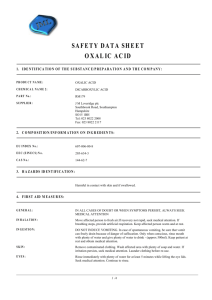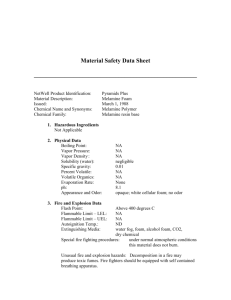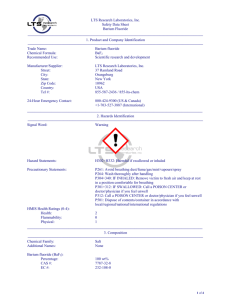Product Name : BARIUM PHOSPHATE
advertisement
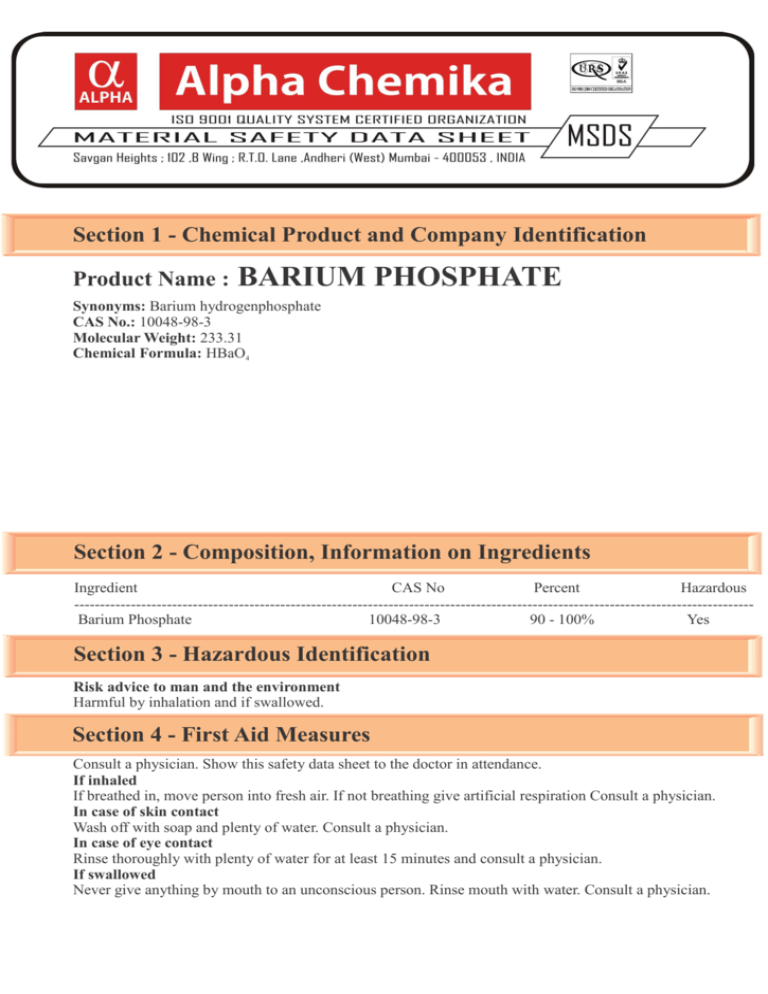
Section 1 - Chemical Product and Company Identification Product Name : BARIUM PHOSPHATE Synonyms: Barium hydrogenphosphate CAS No.: 10048-98-3 Molecular Weight: 233.31 Chemical Formula: HBaO4 Section 2 - Composition, Information on Ingredients Ingredient CAS No Percent Hazardous -----------------------------------------------------------------------------------------------------------------------------------Barium Phosphate 10048-98-3 90 - 100% Yes Section 3 - Hazardous Identification Risk advice to man and the environment Harmful by inhalation and if swallowed. Section 4 - First Aid Measures Consult a physician. Show this safety data sheet to the doctor in attendance. If inhaled If breathed in, move person into fresh air. If not breathing give artificial respiration Consult a physician. In case of skin contact Wash off with soap and plenty of water. Consult a physician. In case of eye contact Rinse thoroughly with plenty of water for at least 15 minutes and consult a physician. If swallowed Never give anything by mouth to an unconscious person. Rinse mouth with water. Consult a physician. Section 5 - Fire Fighting Measures Suitable extinguishing media Use water spray, alcohol-resistant foam, dry chemical or carbon dioxide. Special protective equipment for fire-fighters Wear self contained breathing apparatus for fire fighting if necessary. Section 6 - Accidental Release Measures Personal precautions Use personal protective equipment. Avoid dust formation. Avoid breathing dust. Ensure adequate ventilation. Environmental precautions Do not let product enter drains. Methods for cleaning up Pick up and arrange disposal without creating dust. Keep in suitable, closed containers for disposal. Section 7 - Handling and Storage Handling Avoid formation of dust and aerosols. Provide appropriate exhaust ventilation at places where dust is formed. Normal measures for preventive fire protection. Storage Store in cool place. Keep container tightly closed in a dry and well-ventilated place. Section 8 - Exposure Controls, Personal Protection Personal protective equipment Respiratory protection Where risk assessment shows air-purifying respirators are appropriate use a dust mask type N95 (US) or type P1 (EN 143) respirator. Use respirators and components tested and approved under appropriate government standards such as NIOSH (US) or CEN (EU). Hand protection The selected protective gloves have to satisfy the specifications of EU Directive 89/686/EEC and the standard EN 374 derived from it. Handle with gloves. Eye protection Safety glasses with side-shields conforming to EN166 Skin and body protection Choose body protection according to the amount and concentration of the dangerous substance at the work place. Hygiene measures Handle in accordance with good industrial hygiene and safety practice. Wash hands before breaks and at the end of workday. Section 9 - Physical and Chemical Properties Appearance Form powder Colour white Safety data pH no data available Melting point no data available Boiling point no data available Flash point not applicable Ignition temperature no data available Lower explosion limit no data available Upper explosion limit no data available Water solubility no data available Section 10 - Stability and Reactivity Storage stability Stable under recommended storage conditions. Materials to avoid Strong oxidizing agents Hazardous decomposition products Hazardous decomposition products formed under fire conditions. - Oxides of phosphorus, Barium oxide Section 11 - Toxicological Information Acute toxicity no data available Irritation and corrosion no data available Sensitisation no data available Chronic exposure IARC: No component of this product present at levels greater than or equal to 0.1% is identified as probable, possible or confirmed human carcinogen by IARC. Signs and Symptoms of Exposure To the best of our knowledge, the chemical, physical, and toxicological properties have not been thoroughly investigated. Potential Health Effects Inhalation Harmful if inhaled. May cause respiratory tract irritation. Skin May be harmful if absorbed through skin. May cause skin irritation. Eyes May cause eye irritation. Ingestion Harmful if swallowed. Target Organs Heart, Nerves., Kidney, Gastrointestinal tract, Bone marrow, Spleen., Liver, Section 12 - Ecological Information Elimination information (persistence and degradability) no data available Ecotoxicity effects no data available Further information on ecology no data available Section 13 - Disposal Considerations Product Observe all federal, state, and local environmental regulations. Contact a licensed professional waste disposal service to dispose of this material. Dissolve or mix the material with a combustible solvent and burn in a chemical incinerator equipped with an afterburner and scrubber. Contaminated packaging Dispose of as unused product. Section 14 - Transport Information ADR/RID UN-Number: 1564 Class: 6.1 Packing group: III Proper shipping name: BARIUM COMPOUND, N.O.S. (Barium hydrogenphosphate) IMDG UN-Number: 1564 Class: 6.1 Packing group: III EMS-No: F-A, S-A Proper shipping name: BARIUM COMPOUND, N.O.S. Marine pollutant: No IATA UN-Number: 1564 Class: 6.1 Packing group: III Proper shipping name: Barium compound n.o.s. Section 15 - Regulatory Information Labelling according to EC Directives EC Label Hazard symbols Xn Harmful R-phrase(s) R20/22 Harmful by inhalation and if swallowed. S-phrase(s) S28 After contact with skin, wash immediately with plenty of water. Section 16 - Additional Information References: Not available.
